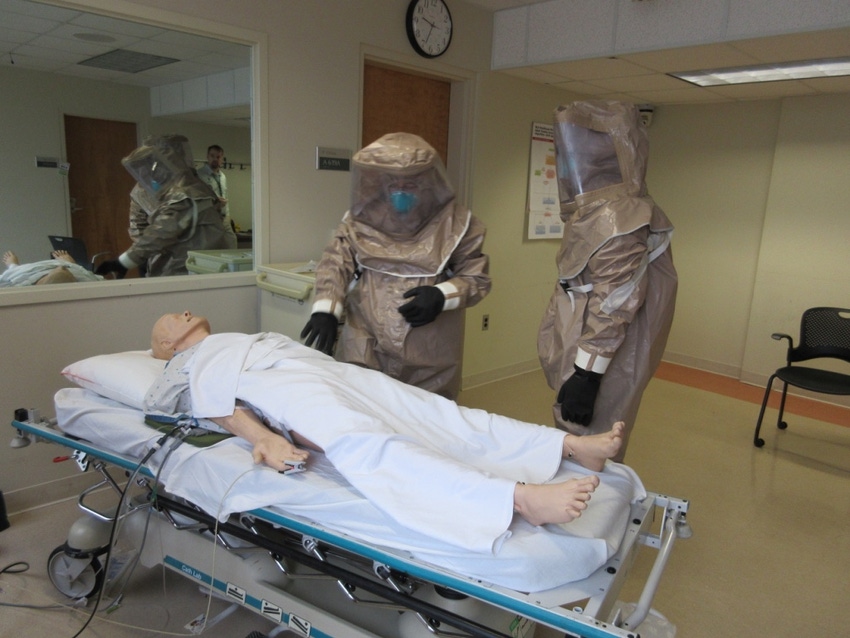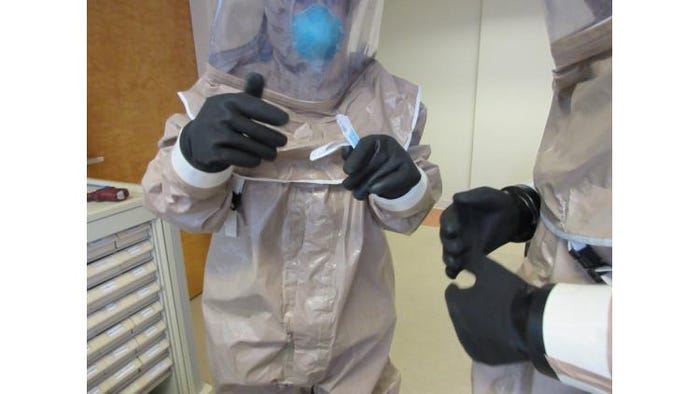October 28, 2016

Packaging conferences typically don’t take attendees outside their comfort zones. Unless, of course, it’s the Healthcare Packaging Immersion Event. Held at Michigan State University (MSU) October 12-13, the two-day conference immersed attendees in slightly stressful simulations that encouraged them to re-examine how end-users interact with healthcare packaging. Faculty and students from the MSU School of Packaging, the Learning and Assessment Center, three of four medical colleges on campus at MSU, and even the Center for Anti-Counterfeiting and Product Protection joined FDA and industry to offer different perspectives on packaging’s role in infectious disease treatment, geriatric care, and other scenarios.
During day one, attendees were asked to don N95 masks during a simulation in which an audience member “fell ill,” potentially from an infectious disease that had just been “reported” on campus. The “patient” was whisked away and treated by paramedics wearing personal protective equipment (PPE) suits. The audience watched a video feed of healthcare professionals as they struggled to see, hear, talk, and open packages while wearing the bulky suits. The participants then came together for a panel discussion.
Participant Amy Crisp, MSN RN, told the audience that it was hard to open packages with small tabs or flaps while wearing PPE suits.
Another participant, Kim Loomis, MSN RN, added that PPE gloves are one-size-fits-all, making dexterity hard for professionals with small hands. She also added that one “can’t hear and the temperature increased” inside the suits, further complicating the situation. “With a mask and a shield, you can’t see, and there’s a lot of reflection and heat and no airflow,” she said.
And with gloves on, “you lose tactile [feel],” she added. While opening sterile packages, “it’s challenging to know how much force is needed to open [them],” she said. “If it rips, I may need to bring in more products.” She also asked the audience to consider “the organization of a kit and how the nurse will remove items from it.”
Francie Pouch Downes, an MSU professor who joined the panel and dons the gear to run laboratory tests on collected samples, explained that “the face shield can make reading nearly impossible.” She asked for “larger and darker” fonts that aren’t fancy, and Crisp asked for text “printed on a contrasting background.”
Downes also added that suited lab technicians also need to maintain sterility when handling specimens, so they, too, face challenges when opening packages such as bottles and tubes of reagents.
When asked how often healthcare professionals wear PPE during their day-to-day jobs, participant Brent Davenport, a firefighter and paramedic who serves as a HAZMAT team leader, said use is “infrequent enough that we aren’t completely comfortable with the gear.” However, “if I‘m interacting with your product all the time, I’m familiar with how to use it. Even if I can’t feel it or see it, I know how to open it.” He spoke of being frustrated with changes in suppliers or packaging.
Davenport expressed a preference for universally designed packaging. He spoke of situations for which they cannot anticipate the equipment they would need, so it would be helpful for packaging to be designed to be easy to use in all environments.
After the panel discussion, two audience members volunteered to don PPE suits for a few moments. They, too, spoke of the challenges hearing and seeing.
To further provide the audience with a suited healthcare worker’s perspective, MSU HUB researcher Eric Estrada wore a GoPro inside a PPE suit and attempted to open packages. The footage showed how humidity building up on the inside of the PPE shield impaired vision, making it difficult to see and handle products and packaging and to communicate with others.
The simulation, GoPro footage, and panel discussion prepared the audience for the evening’s keynote speaker, Commander Mary Brooks, RN, BSN, MS, U.S. Public Health Service and Senior Lead Reviewer for FDA’s CDRH. She spoke about treating patients in Liberia during the Ebola outbreak. She and members of her team received extensive training for suiting up and treating patients in a manner that would protect healthcare workers and patients from cross contamination.

Simulation participants struggled to open packages while wearing PPE suits. Image provided by MSU.
Day two’s simulation explored a very different situation: aging. Just before lunch, attendees were given immersive devices for use during the break. These included vision-restricting glasses to mimic eye conditions such as macular degeneration, glaucoma, and others as well as braces and canes to limit mobility and dexterity.
While explaining the exercise, Laura Bix, Professor and Associate Director at the MSU School of Packaging, said that the “healthcare system is changing to put the patient at the center, moving from piecemeal procedural reimbursement . . . to systems tied more directly to health outcomes.” Such changes mean that product development is moving from “product-centered design toward user-centered design.” One of the drivers, she said, is maintaining the health of the aging population.
Attendees then navigated a buffet lunch while wearing their immersive devices and were asked to open child-resistant medicine bottles and complete a written questionnaire. Attendees later spoke of struggling to serve themselves from the buffet and of difficulties in seeing and conversing with others and opening bottles. A few attendees described feeling “isolated,” and some said they helped others.
After lunch, Bix told the audience that “packaging can be the difference between living independently and living assistedly. If you can keep patients living independently, it is more affordable, even if the packaging costs $1 more.”
The lunchtime immersion was followed by presentations and a panel discussion on home health and geriatrics. Speaker Erin Sarzynski, MD MS, MSU Assistant Professor, gerontology, encouraged attendees to consider the needs of senior patients, pointing out this article: “Are seniors top of mind when you design your packages?”
Focusing on home care is essential, because the “future is outside of acute care,” added speaker Linda Keilman, DNP, GNP—BC, MSU Assistant Professor and Gerontological Nurse Practitioner. “Hospitals are too expensive.”
Also, “patients want to be home . . . and maintain their quality of life,” she continued. “If people get ‘wrap rage’ when trying to get something out of a package, they won’t buy your equipment.” Some specific packaging suggestions she offered included use of bigger fonts, symbols, and color as well as opening features that require the use of a lateral pinch. “Less strength and dexterity is required,” she explained.
“It doesn’t work if you can’t get into it,” she said.
Easy-to-use packaging could keep patients at home, especially after returning from a hospital stay. Sarzynski explained that she routinely works with patients in hospitals and says that “if there is any hope of their going home, they will need a caregiver to manage dressing changes and medications,” and they’ll need “easy-to-use packaging.”
Keilman listed a number of healthcare products often used at home, such as medications and products for wound care, catheterization, and GI stoma. The latter is a “really huge area because it is hard to get bags out of containers and not contaminate them,” she said. Other packaged products include oxygen and IV tubing, supplies for patients on respirators, and braces for shoulders, wrists, and knees. It is important for family members serving as caregivers to not spread infection, so improvements in glove and tissue dispensers would be helpful, too, she added.
“We need to cut costs of healthcare and improve quality. You are in the driver’s seat, because you can change healthcare with packaging,” she told the audience.
Debra Lindstrom, PhD, OT, Professor, Western Michigan University, told the audience that it is difficult for patients to get the same coverage for supplies in the home as they would in the hospital. When the panel was asked what could change that, Keilman told the audience to “do research. If you can prove packaging doesn’t cause wrap rage or cause secondary injuries, decreases frustration, and increases well-being. . .if you can prove something works, [payers] will be willing to pay.
“I sit on a CMS committee, and part of our hope is that baby boomers are outspoken,” Keilman continued. “But we don’t have numbers or statistics. CMS says we need numbers and to see outcomes. So do your focus groups and write it up. They didn’t cover wheelchairs before, so there’s hope, and we should try.”
Coverage for products that help improve health outcomes appears to be consistent with the mission of the Patient Protection and Affordable Care Act (ACA), which speaker Randolph Rasch described as transitioning the U.S. healthcare system from a “pay-for-service to a pay-for-outcomes” approach. Rasch, Dean of the MSU College of Nursing, said that the ACA focuses on “wellness, prevention, minimizing repetition, and reducing costs.” He noted that patients today are in the hospital a shorter time and then have to go home and manage their care. “Most of our care is moving into the community,” he said.
Regarding home healthcare, he suggested packaging products in ways that make them easier to use, but don’t cost more.
Such perspectives along with the simulations demonstrated the importance of researching how users interact with packaging, a topic explored by Shannon Hoste, Human Factors Pre-Market Evaluation Team Member in FDA’s CDRH. Speaking on human factors, Hoste said that it is “relatively new that we’ve been asking about it in PMAs,” but it “is part of design controls and part of the development process for packaging and labeling.
"The user interface [needs to] support safe and effective use. User error is considered a nonconformity,” she said.
Hoste advised attendees to determine “the critical tasks for packaging” and then “design a human factors study to look at critical tasks and simulate end use.” The study is “a dry run for your products to see what could go wrong,” she said.
Other speakers examined healthcare packaging trends, challenges, and solutions. Stay tuned for more coverage.
Overall, Bix hopes that [healthcare] would move from “a system of fragmented siloed processes . . . to a comprehensive system that puts the patient at the center of everything.”
About the Author(s)
You May Also Like




